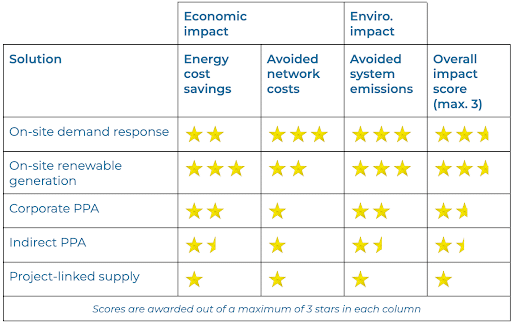Contributed by Paul Coster, Founder of EVA Marketplace
Given the need for businesses to slash fossil fuel consumption, part 1 asked the burning question, ‘can backing renewables be both a pragmatic commercial decision and contribute to climate action?’ I then explained that the climate-friendly way for most New Zealand businesses to back renewable energy is through electricity, by both demand response and supporting additional renewable generation.
Here in part 2, I will start by detailing the solutions available to businesses, explain the role played by energy certificates, and then discuss which solutions can have the most impact.
Solutions
Readily available solutions for supporting renewable electricity are shown below. Each of these solutions requires an electricity supply agreement, and some require a power purchase agreement (PPA). See this recent blog post by EVA to learn more about PPAs and how they differ from supply agreements.
Businesses can combine solutions for greater impact, such as having demand response, on-site generation, and a corporate PPA. In all cases, a relationship with an electricity retailer is retained.
1. Demand response
Technology is installed on the business’s site that allows electrical equipment (including battery storage) to respond to changes in the electricity market, such as high prices or plentiful renewable generation.
2. On-site generation
Renewable generation is installed on or near the business’s site. The project is owned by the business, or owned by a developer who agrees to sell the electricity onto the business via an on-site PPA.
3. Corporate PPA
Renewable generation is constructed remotely (‘off-site’). The project is owned by a developer who agrees to sell the electricity to the business via a corporate PPA, helping to financially support their project. The corporate PPA will typically be sleeved (bundled) into the business’s supply agreement.
4. Indirect utility PPA
Renewable generation is constructed off-site. The project is owned by a developer who agrees to sell the electricity onto a retailer via a utility PPA, helping to financially support their project. The retailer on-sells the electricity to the business under similar terms using PPA sleeving (bundling).
5. Project-linked supply
Renewable generation is constructed off-site. The generator agrees to sell the project’s renewable attributes onto a retailer via energy certificates. The retailer passes the certificates onto the business under their electricity supply agreement or another agreement.
Energy certificates
Energy certificates play an essential role for these solutions where renewable electricity is exported into a network. The certificates track renewable attributes for each unit of electricity, avoiding double counting (*1) and reducing the chance of mis-leading claims (*2).
Currently, energy certificates don’t consider the impact of a solution, such as its economic, environmental or social benefits. In New Zealand, issuers of energy certificates are Brave Trace. (NZ-ECs) and Energy Market Services (iRECs). Certified Energy recently announced future plans to add an impact attribute to their certificates.
Impact
In assessing the potential impact of each solution, we’re going to focus on their economic and environmental impact. The social impact of each solution will greatly depend on the approach taken by the project developer (e.g. community involvement and initiatives).
In order to assess potential impact, I considered various factors, including these three key solution characteristics by asking the following questions:
- Additionality: To what extent would the avoided system emissions have occurred in absence of the solution?
- Location: How does the physical location of the solution (on-site or off-site) affect energy cost savings and avoided costs or emissions?
- Timing: How does the timing of the demand response or electricity generation affect energy cost savings and avoided costs or emissions?
A broad brush assessment of each solution’s potential impact, based on NZ’s current market and the evidence I’ve seen, is shown below. In the complex real-world, the impact will vary for each individual solution (or combination of solutions) and, in the case of demand response, how it is operated day-to-day. Discussion of real-world impact is rich and requires its own series of blog posts.

Generally, demand response and on-site generation, particularly when combined, have the highest potential for commercial and climate impact. They’re followed by PPAs, an excellent solution for businesses where on-site solutions aren’t feasible or can’t meet their full electricity needs. Solutions that solely rely on energy certificates, like a project-linked supply, will typically have the lowest impact. Their impact depends on the revenue created by the certificates and how this money is used (businesses should request transparency).
Like part 1, this post is my current thinking, which I hope opens up more discussion about the impact businesses can have on Aotearoa’s clean energy transition.
* References
1. “The GHG emission reductions or removals from the mitigation activity shall not be double counted, i.e., they shall only be counted once towards achieving mitigation targets or goals”, Core Carbon Principles, The Integrity Council
2. Energy certificates can be used to claim lower scope 2 emissions, and are therefore a form of carbon credit or offset. To be high integrity offsets, they should align to The Integrity Council’s Core Carbon Principles.
